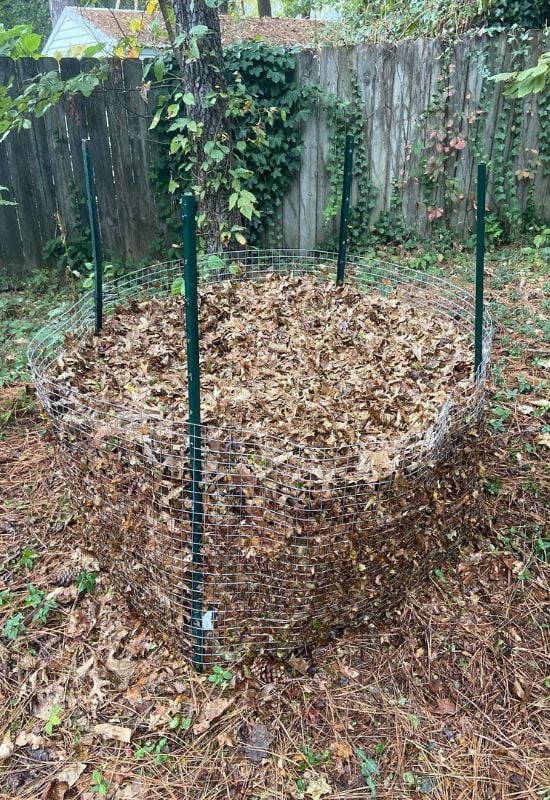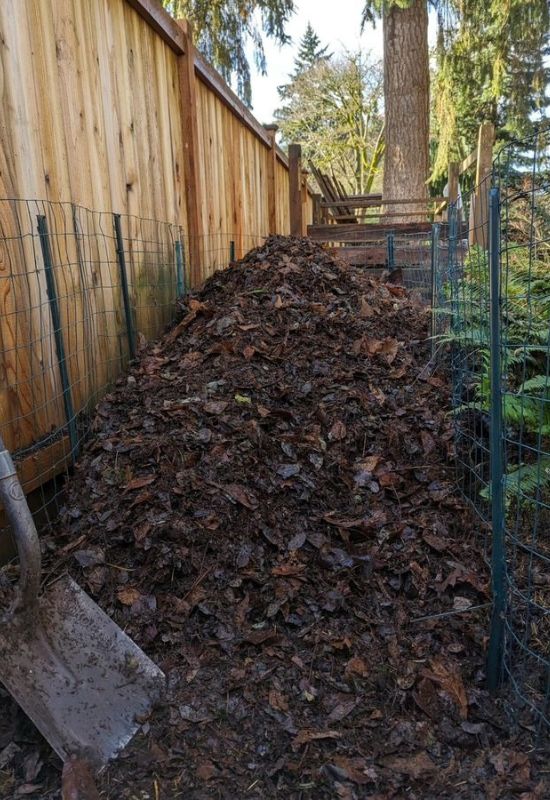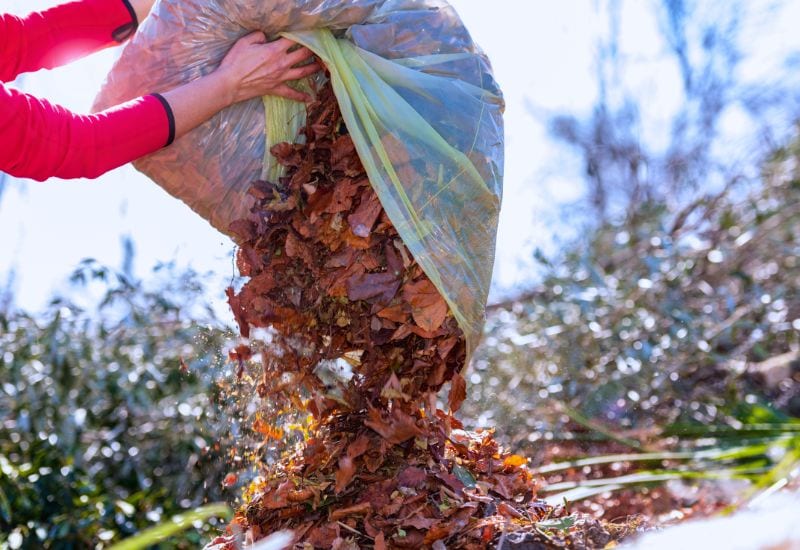
Falling leaves are one of the beauties of autumn. But just because they are beautiful doesn’t mean they can’t be practical, and we can show you how to turn them into rich compost in no time at all.
On their own, leaves can take a couple of years to break down, but if you want to have great compost in just a few months, start by selecting the best leaves that will break down quickly. Then, shred those leaves and start building your compost pile. Once your pile is getting hot, turn it about twice a week to keep the decomposition process going, and even if you have to shut it down for the winter, you can start turning it in the spring again to create a perfect soil amendment just in time for planting.
Keep reading to learn 5 steps to make leaf compost fast so you will be able to add this rich humus to your garden in the spring.
What Leaf Compost Will Do For Your Garden
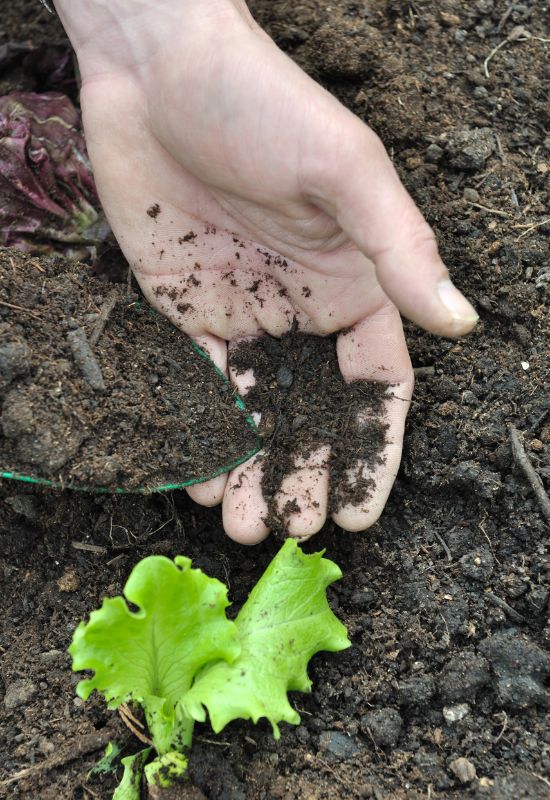
Leaf compost is an incredible soil amendment for your garden. Well made leaf compost will:
- Build soil
- Improve texture
- Aerate the soil
- Add nutrients that are easily absorbed
- Increase drainage
- Improve water retention
- Add nutrients
But can’t you make compost out of any yard waste, plant matter, or manure? Yes, you can, but leaves have some added perks: they break down quickly (when mixed to a proper carbon to nitrogen ratio), create a truly superior soil conditioner, reduce yard waste that ends in dump, and they are free!
And since you can make leaf compost in the fall, it is ready to put in your garden as soon as spring arrives.
How To Make Fast Leaf Compost
Once you have all your leaves raked up, it is time to get started. Of course, you don’t want to only use leaves. If you do, your compost pile won’t decompose properly and will take several years to full decompose.
You want to have your compost a mix of brown (organic matter high in carbon), and greens (nitrogen-rich organic matter). Your leaves are brown matter, so you want to also include some green matter, such as:
- Grass clippings
- Animal manure
- Kitchen scraps
- Yard waste (like your bean vines, zucchini plants, and any other plants you pull from your garden in the fall)
When building your leaf compost pile, make sure it is a balanced mix of equal parts (1:1) carbon and nitrogen.
Compost is made when microbes digest the organic matter. The microbes in compost heaps actually eat around 30 parts carbon for every 1 part nitrogen, so why should you mix it 50/50? This is mostly because brown matter also contains small amounts of nitrogen, and green matter also contains a fair bit of carbon, so when mixed equally you generally end with a 30:1 ratio.
If you have too many leaves, the pule will be dry and won’t heat up so decomposition will be very slow. If you have too many greens, you will have a stinky, gooey, anaerobic mess.
The ratio of browns and greens is measured in volume not by weight. The easiest way to make a balanced mix is it put down a 15cm (6inch) layer of browns, then the same amount of greens, and so on until your bin is full.
1. Choose The Best Leaves
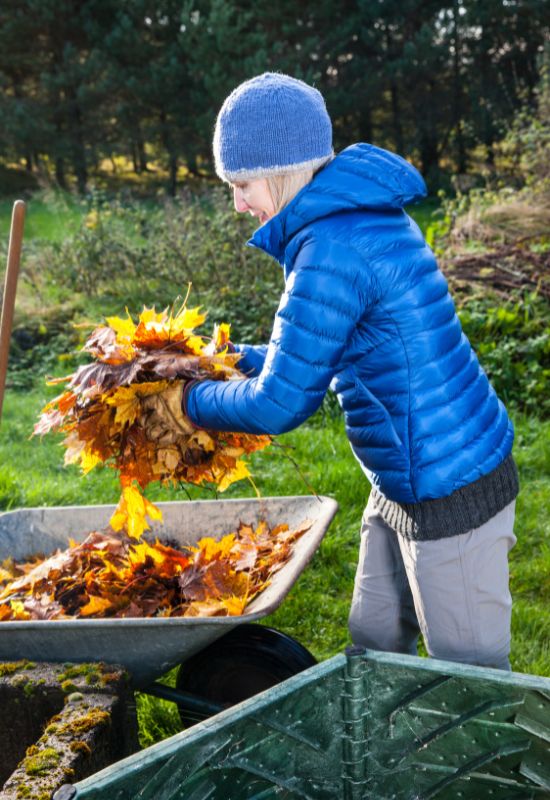
While no two gardens are the same, all leaves are not created equal. So if you are looking to make fast compost this fall, here are the leaves to look for:
- Maple
- Birch
- Ash
- Cherry
- Cottonwood
- Fruit trees
- Poplar
- Willow
- Elm
These leaves will all break down quickly and are rich in nutrients.
Some sources claim that certain leaves shouldn’t be used because they will make your compost too acidic, but this is not entirely accurate. While some leaves, such as oak which have a pH around 4.5 and 4.7, are too acidic which will interfere with the initial decomposition process. However, the products used in the compost have little effect on the final pH of the compost, so while the oak leaves may slow down the decomposition process, they will have little effect on the finished compost.
Other leaves that will slow down your compost are leaves with waxy, dense leaves. These include magnolia, ginkgo, and pine needles (yes, they technically are leaves).
Leaves To Avoid
There are, however, a few leaves that should be avoided completely. These include black walnut, eucalyptus, horse chestnut, and buckeye: these leaves are either toxic to people and animals, or release chemicals into the soil the inhibit germination.
2. Shred The Leaves
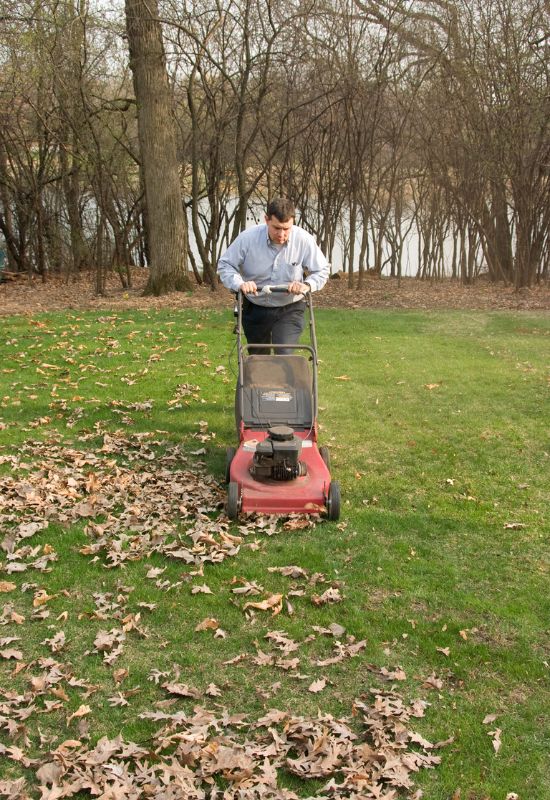
For a fast acting leaf compost, it is very important to shred the leaves first. Shredded leaves break down faster and don’t for a stinky, soggy, anaerobic mat inside the compost pile that you can get when using whole leaves.
Here are some simple ways to shred your leaves:
- Mow Them On The Lawn: If you have a mulching mower (and even if you don’t), mow your lawn before you rake your leaves. Make sure to have your bag attached and the finely shredded leaves, along with grass clippings, will be ready to go into the compost.
- Buy A Leaf Shredder: If you are really serious about leaf composting, or if you have a lot of leaves, then you might want to invest in a leaf shredder. There are either gas or electric models available and this can be quite an effective method.
- Use A Weed Wacker: Once you rake your leaves, put them in a garbage can, and stick your weed wacker inside. While it might be a bit messier than the other methods, you will have very nicely shredded leaves for very little time and cheap.
3. Add Soil Or Not?
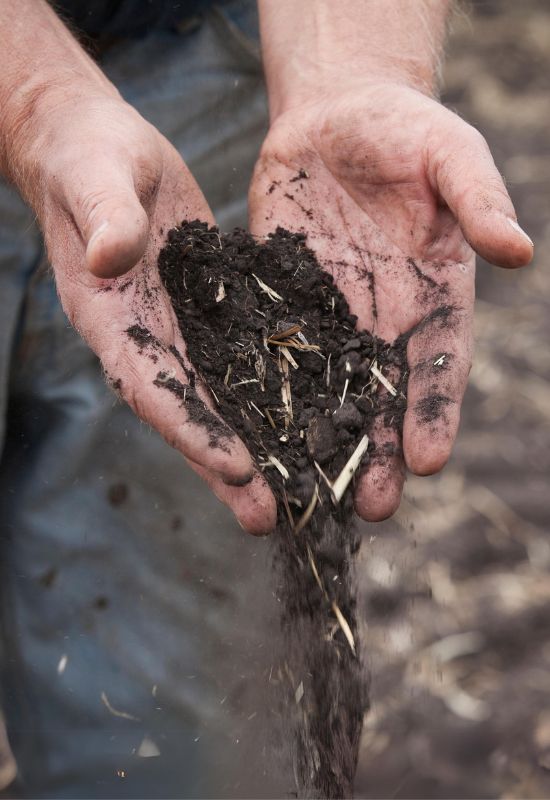
Some gardeners swear by adding a bit of soil to their compost while others say not to, and this is a very contentious topic amongst composters. The theory is that soil is filled with microbes, so adding it to your compost releases the microbes to your heap and it will decompose faster. The opposers say that the organic matter you add is already teeming with billions of microbes so it is unnecessary to add any more.
For me, I have never added soil to compost and do not feel that it is necessary, but adding a little bit won’t do any harm, and it might make leaf compost faster than ever.
If you do add soil, make sure you do not add too much. Adding too much can dilute your brown/green ratio, reduce the temperature of your pile, and slow down the process.
What About Compost Starter?: Whether you add soil or not, I would strongly discourage buying and adding compost starter (sometimes called compost activator). These products are either microbe inoculants, enzymes, and in some cases, they are simply nitrogen fertilizer: none of which are necessary for a well build compost pile.
4. Make Your Pile The Right Size
Almost as important as what you put in your compost is the size of your compost pile or bin. If it is too big, it will be difficult to turn and the centre will cool off too much. If it is too small, it won’t be able to heat up enough and decomposition will be very slow.
Our first compost bins were 4ft x 4ft x 4ft. This size works very well and you can pack in a lot of leaves. They are, however, a bit more work to turn.
We have also built several bins that are 3ft x 3ft x 3ft. While they hold less, they are much easier to turn, which is a great perk when you are trying to make compost fast.
Of course, you can also buy compost tumblers which are smaller but make turning a breeze.
Whichever size you choose, start with a layer of brown, followed by a layer of green, until you fill the bin.
5. Turning Compost Pile
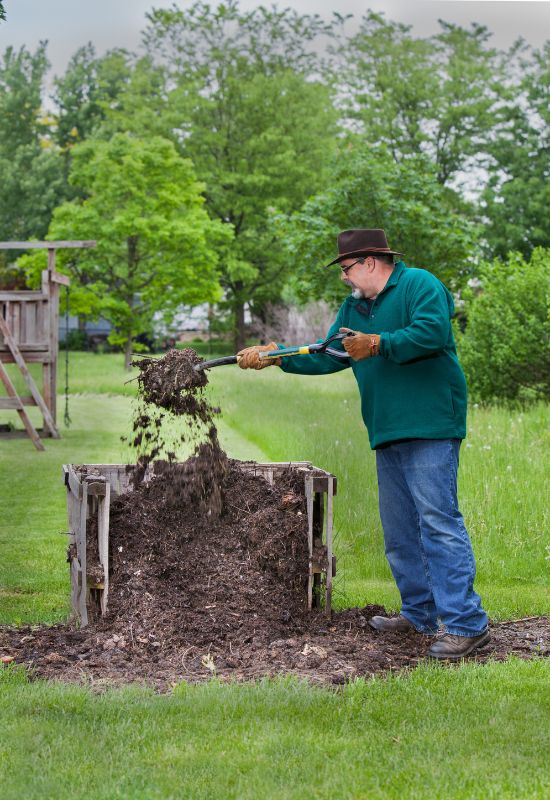
Now that you have everything piled together, its time to get to work and turn your compost. Turning lets oxygen into the pile for the microbes, and the temperature will stay nice and hot showing that the decomposition in taking place. If the pile begins to cool, it means decomposition has slowed and your pile isn’t making compost as fast.
Ideally you want to turn your compost pile twice a week until it freezes. If this isn’t feasible, then aim for once a week and you will still have excellent compost when you need it in the spring.
As you turn, you might find the pile is too dry. In this case, you can add some water but make sure you don’t add too much or you will drown the organisms and create an anaerobic mess. (Alternatively, if it is raining too much, consider covering your compost to keep it from getting saturated).
Winter Care
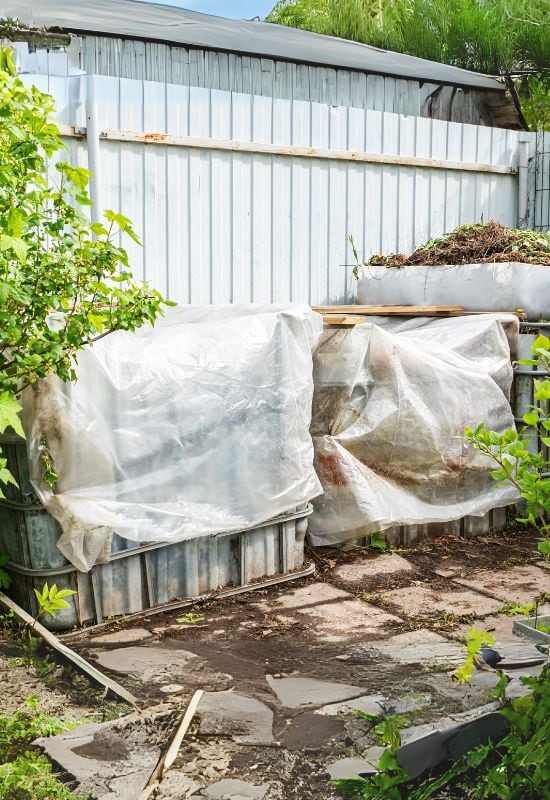
Sometimes, winter is so cold that no matter what you do, your pile will freeze solid and you will have to wait until spring before you can turn it. However, here are some winter care tips to help keep your leaf compost working over winter:
- Insulate With Straw: By insulating your pile (we find straw is the best for this), it keeps the pile warmer for longer. Even if you are not able to turn it, decomposition will still occur though it will be slower.
- Cover: Put a cover on your compost if you expect lots of snow or heavy rain. If the compost gets too wet, it won’t be able to decompose as well and nutrients will be washed away.
- Choose A Sunny Location: By putting your compost bin in a sunny spot, it will stay warmer and so you can hopefully turn it for longer (or start again earlier in the spring).
- Start Again In The Spring: As soon as your pile has thawed out, get in there and start turning. We have started turning some of our piles while they were still frozen in the middle, and reactivating the decomposition process helped to thaw them out faster.
How To Use Leaf Compost
When spring rolls around, your leaf mold should be ready to go. Even if it is not quite ready first thing, giving it a few more turns will get the decomposition process going and it should be finished in no time.
Spring is generally the best time to apply leaf compost as it replaces any nutrients that were lost the previous growing season, and these nutrients are immediately available to your newly emerging seedlings.
Spread 2cm to 3cm (1 inch) of your finished leaf compost on your garden before or after planting your annuals, and around any perennials. This amount is just a guideline: your garden might need more depending on the condition of your soil so adjust it as necessary.
Didn’t use all your leaf compost in the spring? Don’t worry! While spring is the best time to apply compost, your leaf compost will keep very well and you can use it through the summer, fall, or even next winter.
Other Ways To Use Leaves In Fall
Making great compost isn’t the only way you can use leaves in the fall, and one of the best ways is to create leaf mold (as nasty as the name sounds, this is a good mold in your garden!). While the process to create leaf mold often takes a year or even two, check out my other article for how to quickly create leaf mold in a few short months.
Also, by shredding them as we discussed above, you can use leaves as a really awesome fall mulch around your perennials, to extend your season (LINK), or to protect the soil in fallow annual beds.
Conclusion
What better way to spend your fall than preparing your garden for next year! Leaves fall all around us, and while many see them as an inconvenient chore to rake them up, I hope you are inspired to try these quick and simple tips to make incredible leaf compost for your spring garden.

Written By
Amber Noyes
Amber Noyes was born and raised in a suburban California town, San Mateo. She holds a master’s degree in horticulture from the University of California as well as a BS in Biology from the University of San Francisco. With experience working on an organic farm, water conservation research, farmers’ markets, and plant nursery, she understands what makes plants thrive and how we can better understand the connection between microclimate and plant health. When she’s not on the land, Amber loves informing people of new ideas/things related to gardening, especially organic gardening, houseplants, and growing plants in a small space.

